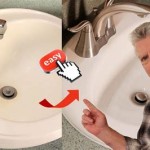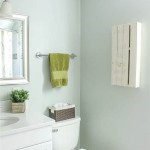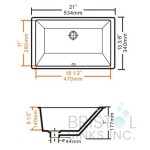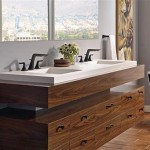Understanding Hot and Cold Bathroom Faucets: A Comprehensive Guide
Bathroom faucets are essential fixtures in any residential or commercial property, providing access to water for various hygiene-related tasks. Among the myriad options available, hot and cold faucets remain a prevalent choice. These systems supply both heated and cooled water separately, offering users control over water temperature for a comfortable and efficient washing experience. This article provides a detailed overview of hot and cold bathroom faucets, delving into their operation, types, maintenance, and factors to consider when selecting them.
Hot and cold faucets, in their most basic form, consist of two handles or knobs, one designated for hot water and the other for cold. These handles connect to separate water supply lines. When a handle is turned, it opens a valve allowing water from the corresponding supply line to flow through the faucet spout. The user adjusts the position of each handle to achieve the desired water temperature by blending the hot and cold streams. This design is simple and relatively inexpensive, making it a popular choice for many applications.
The internal mechanism of a hot and cold faucet typically relies on compression valves, ball valves, or ceramic disc valves. Compression valves utilize a rubber washer that presses against a valve seat to stop the flow of water. Ball valves employ a ball with a hole through it, which aligns with the water inlet when the valve is open and obstructs the flow when closed. Ceramic disc valves use two ceramic discs with aligned holes that slide against each other to control water flow. Each valve type offers varying degrees of durability and resistance to leaks.
Operation and Functionality
The primary function of hot and cold bathroom faucets is to deliver water at a user-specified temperature. The user manually manipulates the hot and cold water handles to regulate the proportion of hot and cold water being mixed. This allows for precise temperature control, accommodating individual preferences and specific needs, such as handwashing, shaving, or teeth brushing. The separate control of hot and cold water also facilitates conserving hot water when only cold water is needed, potentially reducing energy consumption and water heating costs.
The simplicity of the design also contributes to the ease of use and maintenance of these faucets. The straightforward mechanics typically make repairs less complex, allowing homeowners to address some issues themselves. The readily available replacement parts further simplify maintenance and extend the lifespan of the faucet.
However, the independent control mechanism can sometimes lead to inefficiencies. Users may inadvertently use more water while adjusting the temperature, as they must allow both hot and cold water to run until the desired temperature is reached. Furthermore, achieving a consistently precise temperature can be challenging, particularly with older faucets or those with worn valves. The temperature can also fluctuate slightly as the water pressure changes. Despite these minor drawbacks, the overall functionality of hot and cold faucets remains effective and reliable for everyday use.
Installation of hot and cold faucets is generally straightforward, particularly in bathrooms already plumbed with separate hot and cold water lines. However, it is crucial to ensure proper sealing and connections to prevent leaks. Using plumber’s tape or pipe dope on threaded connections is advisable. The faucet body needs to be securely mounted to the sink or countertop to prevent movement during use. Proper installation will ensure the faucet functions correctly and prevents water damage to the surrounding area.
Types of Hot and Cold Bathroom Faucets
While the basic principle of hot and cold faucets remains consistent, variations exist in design, style, and materials. These variations cater to different aesthetic preferences and functional requirements. Understanding the different types can help in selecting the most suitable option for a particular bathroom setting.
One common distinction lies in the handle design. Lever handles offer easy grip and operation, making them suitable for individuals with limited dexterity. Cross handles provide a classic and traditional look and are often found in older homes or bathrooms with a vintage aesthetic. Knob handles offer a more compact design and can be more aesthetically pleasing in certain modern settings.
Another difference is in the spout design. Gooseneck spouts provide ample clearance for washing hands and filling containers. Low-arc spouts offer a more streamlined appearance and are suitable for smaller sinks or bathrooms with limited space. Waterfall spouts create a visually appealing water flow and can add a touch of luxury to a bathroom. The choice of spout design should be based on both functionality and aesthetic preference.
Material selection also plays a significant role in the durability and appearance of hot and cold faucets. Brass faucets are known for their durability and resistance to corrosion. Chrome-plated faucets offer a sleek and modern look and are relatively easy to clean. Stainless steel faucets provide a balance of durability and aesthetic appeal and are often resistant to water spots and fingerprints. The material should be chosen based on budget, desired aesthetic, and the expected level of wear and tear.
Widespread faucets are characterized by their separate hot and cold water handles, which are installed separately from the spout. This design provides a more luxurious and customizable look, with the ability to adjust the spacing between the handles. Centerset faucets have the hot and cold water handles mounted on a single base, typically with a 4-inch center-to-center distance. This design is more compact and suitable for smaller sinks. Single-hole faucets are designed for sinks with only one faucet hole, and they require an adapter to connect to the separate hot and cold water lines. This design offers a minimalist aesthetic and simplifies installation.
Maintenance and Troubleshooting
Proper maintenance is essential to ensure the longevity and optimal performance of hot and cold bathroom faucets. Regular cleaning and inspection can prevent common issues such as leaks, reduced water flow, and mineral buildup. Addressing problems promptly can prevent more significant damage and costly repairs.
One of the most common issues with hot and cold faucets is leaks. Leaks can occur around the handles, the spout, or the base of the faucet. Handle leaks are often caused by worn-out O-rings or valve seats. Replacing these parts is usually a straightforward repair. Spout leaks can be caused by a loose connection or a damaged spout seal. Tightening the connection or replacing the seal can resolve this issue. Base leaks can be caused by a loose mounting nut or a damaged sealant. Tightening the nut or applying fresh sealant can prevent further leakage.
Reduced water flow can be caused by mineral buildup in the faucet aerator or valve cartridges. Removing the aerator and cleaning it with vinegar or a limescale remover can restore normal water flow. Replacing the valve cartridges can also improve water flow, particularly if the cartridges are old or damaged. Periodic cleaning of the faucet body with a mild soap and water can prevent mineral buildup and maintain its aesthetic appearance.
Stiff or difficult-to-turn handles can be caused by mineral buildup or corrosion in the valve mechanisms. Applying a silicone-based lubricant to the valve stems can ease the movement of the handles. Disassembling the faucet and cleaning the valve components can also improve handle operation. Regular use of the faucet can help prevent stiffness and maintain smooth operation.
In cases of more complex issues, such as a cracked faucet body or a severely damaged valve, it may be necessary to replace the entire faucet. Replacing a faucet is typically a straightforward process, but it is essential to shut off the water supply before starting the work. Following the manufacturer's instructions for installation is crucial to ensure a proper and leak-free installation.
Selecting high-quality faucets made from durable materials can significantly reduce the frequency of maintenance and repairs. Faucets with ceramic disc valves are generally more durable and resistant to leaks than those with rubber washers. Regular inspection and preventative maintenance can extend the lifespan of hot and cold bathroom faucets and ensure reliable performance for years to come. Proper care of the faucet's finish will also help maintain its appearance and prevent discoloration or corrosion.
Overall, understanding the operation, types, maintenance procedures, and potential issues associated with hot and cold bathroom faucets can empower homeowners and facility managers to make informed decisions about selection, installation, and upkeep. This knowledge contributes to the longevity and functionality of these essential plumbing fixtures, ensuring a comfortable and efficient bathroom experience.

Shower Faucets Mixer Water Tap Bath Fixtures Waterfall Bathroom Accessories Hot And Cold Metered

Momali Double Handle Wall Mounted Hot And Cold Water Tap Bathroom Bathtub Bath Faucet Faucets Sanitary Ware Made In Com
Bathroom Tap 304 Stainless Steel Cold And Hot Black Household Basin Faucet

Double Couplet Bathroom Faucet Hot And Cold Water Basin Single Holder Dual Hole Base Wash Tap Made In Com

Showy Sink Mixer Swivel Spout 2570mc Hot Cold

Ac Powered Commercial Touchless Single Hole Bathroom Sink Faucet With Deck Plate And Cold Hot Water Mixer In Chrome Hl Dsat620ch The Home

Goldenwarm Hot And Cold Bathroom Faucet 3 Hole Faucets

Popular Design Black Bathroom Faucets Hot And Cold Water Mixer Bath Tub Shower Faucet Set Made In Com

Bathroom Sink Faucets Lavatory For Giving Tree

Modern Basin Faucet Curved Design Bathroom Faucets Hot And Cold Water Mixer Taps For Brushed







